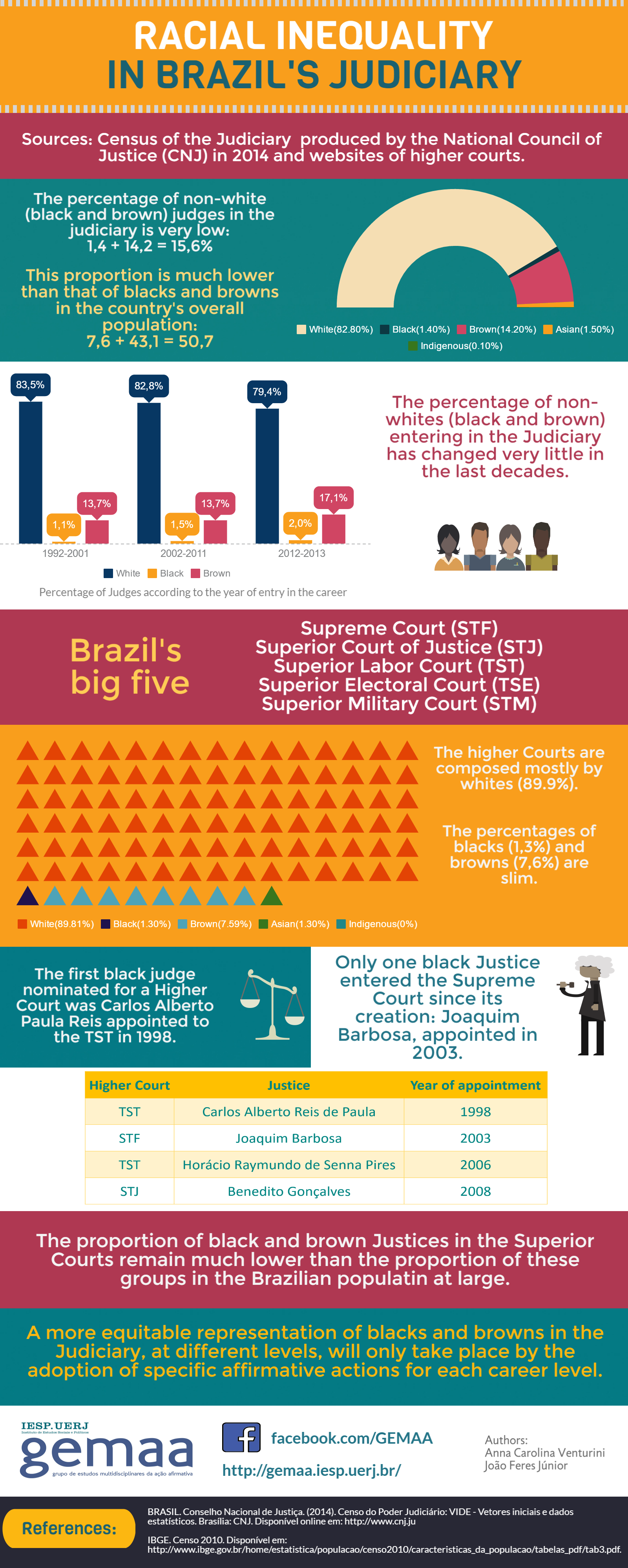Racial Inequality in the Brazilian Judiciary
Racial inequality in the Brazilian Judiciary
Anna Carolina Venturini and João Feres Júnior
This study explores the issue of racial inequality in Brazil’s judicial careers, from 1988 to 2015. Special attention is paid to the five higher courts: the Supreme Court (STF), the Superior Court of Justice (STJ), the Superior Labor Court (TST), the Superior Electoral Court (TSE) and the Superior Military Court (STM).
The data sources used were publicized by the Judiciary Branch, and includes information available on the websites of higher courts about judges and justices holding office during the period under scrutiny.
Although they comprise more than 50% of the Brazilian population, blacks and browns are severely underrepresented in judicial careers, with particular intensity in the top ranks of the careers.
A discouraging aspect regarding the promotion of racial equality, shown by the Census of the Judiciary released by the National Council of Justice (CNJ) in 2014, is that the percentage of black judges did not change significantly between1955 to 2013. In 2013 brown and black held 14.2% and 1.4% of all judicial posts, respectively. These numbers fall rather short of the proportion of these same groups in Brazil’s population, 43.13% for browns and 7.61% for blacks. If only the Higher Courts are considered, racial inequality is even starker: whites take up 89.9% of all posts, while blacks take 1.3% and browns 7.6%.
In June 2015, the CNJ adopted a resolution establishing that all courts of the country must reserve at least 20% of future hirings for blacks and browns. Although the initial access to the judicial career is made through a public competition, promotion to higher courts take into account merit criteria, and other political and corporative factors that are hard to be directly regulated. The adoption of affirmative action and criteria aimed at increasing the participation of non-whites and ensure a more equitable representation at all levels of the judicial career seem to be the most promising solution to solve this serious problem affecting Brazilian society and institutions.
The data sources used were publicized by the Judiciary Branch, and includes information available on the websites of higher courts about judges and justices holding office during the period under scrutiny.
Although they comprise more than 50% of the Brazilian population, blacks and browns are severely underrepresented in judicial careers, with particular intensity in the top ranks of the careers.
A discouraging aspect regarding the promotion of racial equality, shown by the Census of the Judiciary released by the National Council of Justice (CNJ) in 2014, is that the percentage of black judges did not change significantly between1955 to 2013. In 2013 brown and black held 14.2% and 1.4% of all judicial posts, respectively. These numbers fall rather short of the proportion of these same groups in Brazil’s population, 43.13% for browns and 7.61% for blacks. If only the Higher Courts are considered, racial inequality is even starker: whites take up 89.9% of all posts, while blacks take 1.3% and browns 7.6%.
In June 2015, the CNJ adopted a resolution establishing that all courts of the country must reserve at least 20% of future hirings for blacks and browns. Although the initial access to the judicial career is made through a public competition, promotion to higher courts take into account merit criteria, and other political and corporative factors that are hard to be directly regulated. The adoption of affirmative action and criteria aimed at increasing the participation of non-whites and ensure a more equitable representation at all levels of the judicial career seem to be the most promising solution to solve this serious problem affecting Brazilian society and institutions.
